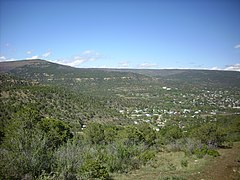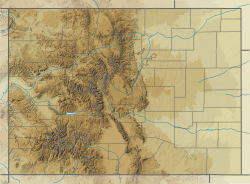| Trinidad Sandstone | |
|---|---|
| Stratigraphic range: Campanian PreꞒ Ꞓ O S D C P T J K Pg N | |
 The Trinidad Sandstone forms a prominent band in the cliffs north of Raton, New Mexico, USA The Trinidad Sandstone forms a prominent band in the cliffs north of Raton, New Mexico, USA | |
| Type | Formation |
| Underlies | Vermejo Formation |
| Overlies | Pierre Shale |
| Thickness | 70–300 ft (21–91 m) |
| Lithology | |
| Primary | Sandstone |
| Location | |
| Coordinates | 37°10′N 104°31′W / 37.17°N 104.51°W / 37.17; -104.51 |
| Region | New Mexico Colorado |
| Country | |
| Type section | |
| Named for | Trinidad, Colorado |
| Named by | R.C. Hills |
| Year defined | 1899 |
  | |
The Trinidad Sandstone is a geologic formation in northeastern New Mexico and southeastern Colorado. It was formed during the Campanian Age of the Cretaceous Period and contains fossils.
Description
The Trinidad Formation consists of a massive fine- to very fine-grained arkosic sandstone some 70–300 feet (21–91 m) in thickness. It rests conformably on the Pierre Shale and is in turn conformably overlain by the Vermejo Formation.
The formation is interpreted as shore deposits marking the final regression of the Western Interior Seaway from northeastern New Mexico. It is correlative with the Fox Hills Sandstone and the Pictured Cliffs Sandstone.
Fossils
The formation contains trace fossils of Ophiomorpha and, in a few locations, Diplocraterion. "Ladders" of Diplocraterion are over 1 meter (3.3 ft) long in the lower part of the formation at Cerrososo Canyon.
Economic geology
There is potential for natural gas extraction from the Trinidad Sandstone. The gas originates in interbedded coal formations.
History of investigation
The beds making up this unit were originally included in Hayden's Raton Hills group in 1869. The name, Trinidad, was first applied by R.C. Hills in 1899, and W.T. Lee (1917) further refined the definition to include only Hills' "Upper Trinidad".
References
- ^ Lee 1917.
- ^ Cather 2004, p. 205.
- ^ Pillmore & Flores 1990.
- Johnson & Wood 1956.
- Cather 2004, p. 216.
- Johnson & Finn 2001.
Bibliography
- Cather, Steven M. (2004). "Laramide Orogeny in Central and Northern New Mexico and Southern Colorado". In Mack, Greg H.; Giles, Katherine A. (eds.). The Geology of New Mexico: A Geologic History. New Mexico Geological Society. pp. 203–248.
- Johnson, Ronald C.; Finn, Thomas M. (June 2001). "Potential for a Basin-Centered Gas Accumulation in the Raton Basin, Colorado and New Mexico" (PDF). U.S. Geological Survey Bulletin. 2184-B. Retrieved 4 September 2020.
- Johnson, Ross B.; Wood, Gordon H. Jr. (1956). "Stratigraphy of Upper Cretaceous and Tertiary Rocks of Raton Basin, Colorado and New Mexico". AAPG Bulletin. 40 (4): 707–721. doi:10.1306/5CEAE400-16BB-11D7-8645000102C1865D.
- Lee, W.T. (1917). "Geology of the Raton Mesa and other regions in Colorado and New Mexico". U.S. Geological Survey Professional Paper. 101: 9–221. Retrieved 4 September 2020.
- Pillmore, Charles L.; Flores, Romeo M. (1990). "Cretaceous and Paleocene rocks of the Raton Basin, New Mexico and Colorado--Stratigraphic-environmental framework" (PDF). New Mexico Geological Society Field Conference Series. 41: 333–336. Retrieved 4 September 2020.